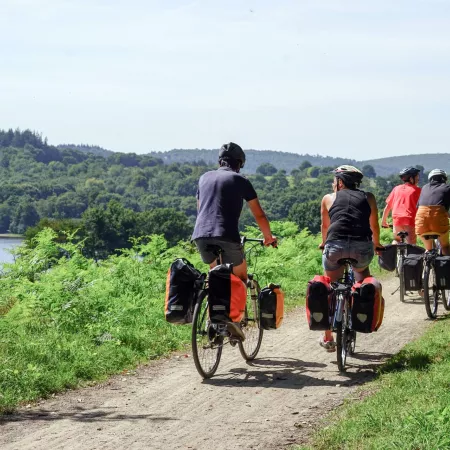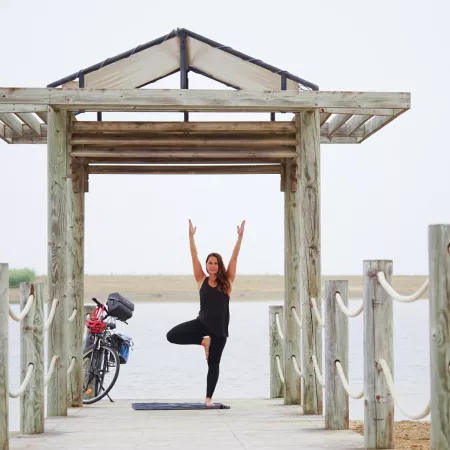How to avoid cycling pain
Here’s how to avoid hurting all over after cycling.
Cycle touring is an exercise you do sitting down. But that doesn’t mean you won’t feel any physical pain. It’s normal for the muscles you use to hurt, but something may be wrong if you have pain in your spine, knees, trapezius muscle or cervical muscles. Often, poor posture and incorrect bike setup are the causes. Here is some advice to improve your comfort and reduce your pain.
Find the right position
It’s not the most obvious, but your position on the bike is likely one of the main causes of cycling pain. If you haven’t made the right adjustments, you may have issues. Before getting in the saddle, take time to check the width of the handlebars, the height and setback of your saddle, the length of your pedal crank and the position of your toe clips. We suggest bringing your multitool with you on the road so you can make adjustments to the position of these items as needed. What matters most is listening to your body and your needs.
Make the right adjustments to avoid bad pain
Here’s a breakdown of things you can do to prevent or stop pain in specific areas.
Neck pain
Pain in this area generally extends to your cervical muscles. This is probably because your saddle isn’t positioned properly. You’ll need to adjust the height of your handlebars and the position of the saddle. Neck pain can also be related to the cyclist’s posture on the bike. Without realising it, you may be raising your shoulders and causing neck pain that way. You’ll need to consciously relax. You’re on vacation, after all!
Upper back pain
Back pain is often caused by incorrect adjustment of your handlebars. If they’re too wide, too narrow or not centred, you may feel pain in your neck and shoulders. Same story if your hand grips aren’t at the same height or your saddle is too high. The recommended posture is to have your chest at a 30° to 35° angle. On your bike, you don’t want to compress or twist your spinal column, so be sure to use your abs. For the super motivated, include some core strengthening in your warm up routine before heading out on your day’s stage and taking in the sights.

Low back pain
Lower back pain is so unpleasant. Once again, this type of pain can be caused by poor saddle adjustment. You’ll need to check the tilt and position of the saddle. As always, the best thing to do is go for a test ride and make adjustments when things don’t feel good. There’s nothing wrong with regularly making adjustments. Even the most experienced cyclists do this before each ride.
Butt pain
While it may seem normal for your behind to hurt when cycling, some of it may be avoidable. To fix this, we suggest choosing a saddle that fits your body shape, needs and practices. There are rounded, semi-rounded, hollow, openwork or flat. The more curved the saddle is, the more comfortable it will be. However, a flatter saddle is recommended for longer rides. Despite common misconceptions, a leather saddle is the best of the best. With time, it conforms to your body and your bum will thank you for that.
Have the right saddle, but still don’t feel good? Try making some adjustments. To relieve saddle pain, you’ll need to ride in a natural position. Be sure to check the tilt, raise or lower the seat or adjust the height of your handlebars.
Kneecap pain
If you feel pain in your kneecaps, it’s highly likely that the height of your saddle needs to be adjusted. But it can also be caused by pedals with too much lateral and angular freedom. This causes your pelvis to move slightly, causing the pain you feel. To remedy this, adjust your pedals and make sure your saddle is still in line with your bike frame. If pain continues, be sure to see an osteopath.
Perineal pain
Choosing the right saddle is essential for avoiding this type of pain. Openwork saddles that provide better comfort are available to help you avoid perineal pain. Don’t make the mistake of choosing a saddle that’s too narrow. It puts too much pressure on your perineal muscles by resting on the pelvic floor, rather than on your sit bone tips. Get a wider saddle if you’re experiencing this kind of pain. You’ll need to adjust the height, tilt, setback and alignment with your bike frame.
As you can see, adjustments are essential for optimal comfort on your bike, especially when you’re headed out on a multi-day cycling tour. Be sure to try things out and make adjustments as you go along. You can also go to a specialised shop to get expert advice and try out products before making a purchase. And if you’re still having cycling pain after making adjustments, be sure to seek medical advice. A posture study can often resolve remaining issues.

